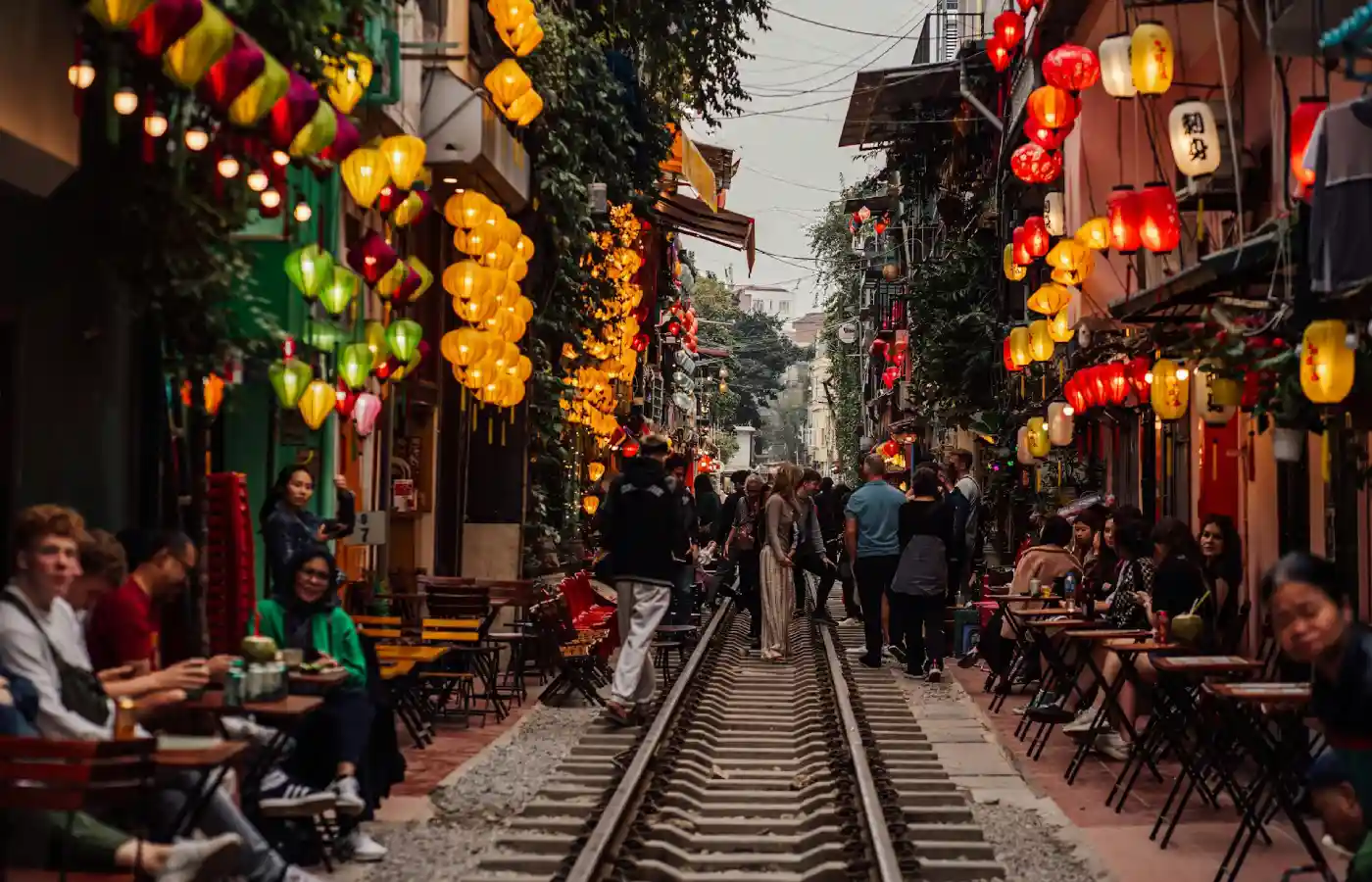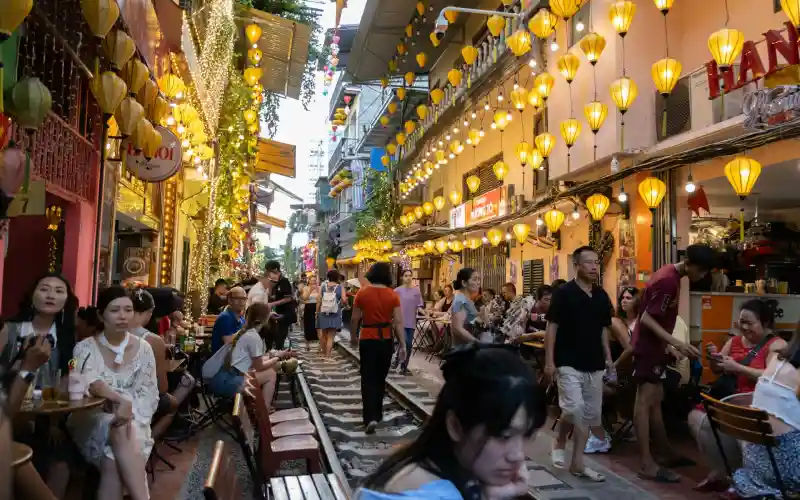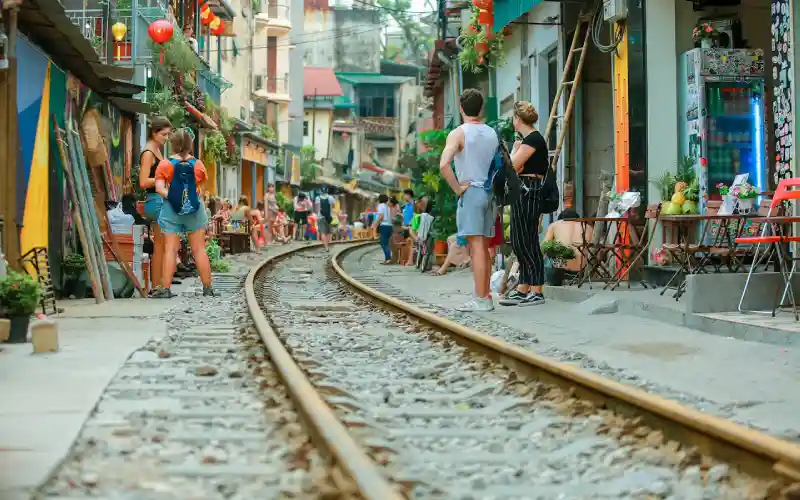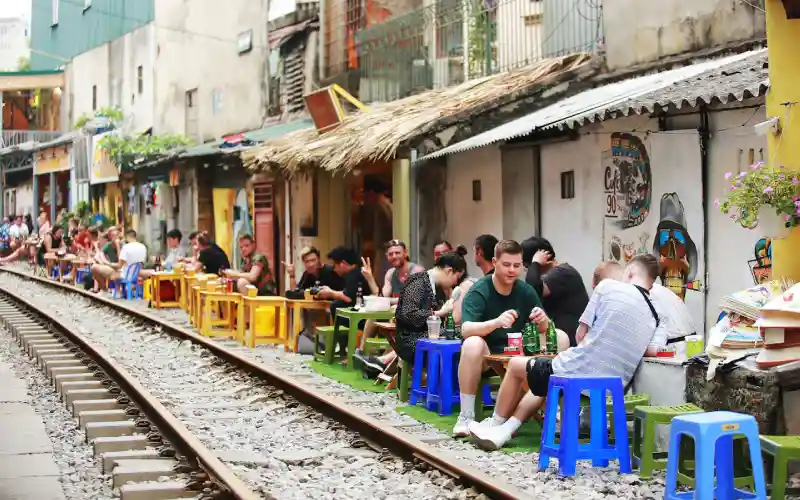Asia is home to a variety of adventures. Some are quite common, like snorkelling or zip-lining, while some are unique to that region and can only be experienced there. For instance, have you ever thought of sipping coffee in a cafe right on the edge of a functional rail track? What’s so adventurous about that, you might wonder. The exciting part is when the train decides to go by, rumbling at a hand’s distance from you. Sounds impressive? It’s even more thrilling to watch it in action. This is Vietnam’s Hanoi Train Street, and here’s everything you need to know about it.
Train Street in Hanoi – Where is it?
Train Street Hanoi is located in the Old Quarter of Hanoi. It was just a normal railway track that was laid by the French in 1902 between Le Duan, Tran Phu, Dien Bien Phu, and Phung Hung, and remains functional even today. Over the years, Vietnamese locals started to build quaint houses, cafés, and shops along the rail tracks, inching quite close to the tracks and making it into a tight alleyway for trains to pass. Though the train street stretches less than a kilometre, it has become a popular attraction for all those visiting Vietnam. Since it isn’t a busy rail line, and having just a few trains running on the track, Hanoi Train Street has a laid-back pace, and when the train approaches, locals swiftly yet gracefully make way for it by clearing their belongings along the tracks. But for visitors, the jittery feel as the train approaches is exhilarating and a fascinating moment, hence a perfect inclusion in Hanoi tour packages.
Schedule and Timings
Though the trains that run on this line are quite limited, the locals know the timings exactly so that they can quickly disassemble and assemble promptly. It’s like a ritual for them. However, tourists who want to experience this spectacle need to be there when trains pass through the tracks.
The trains usually pass at different times throughout the day. The first train passes by at 8:50 am on weekdays and 6:00 am on weekends. The last train is around 10:00 pm or 11:00 pm. Here’s a tentative Hanoi train street schedule:
- On Weekdays: 8:50 am, 9:20 am, 11:45 am, 3:20 pm, 7:00 pm, 7:45 pm, 8:30 pm, 9:20 pm, 10:00 pm.
- On Weekends: 6:00 am, 9:00 am, 11:20 am, 3:30 pm, 5:30 pm, 6:00 pm, 7:00 pm, 7:45 pm, 8:30 pm, 9:00 pm, 11:00 pm.
The Hanoi train street timings are not always punctual, and timings can vary. It would be best to get guidance from locals and cafe owners who know the timings like the back of their hand.
Best Time to Visit Hanoi Train Street
The best time to visit Hanoi is from March to April and September to November. But, for fewer crowds, plan a trip during the cusp of the low and shoulder season, when tourists usually don’t visit Hanoi. Early mornings and late evenings are the preferred times for those who want to take photographs in the best sunlight. So, if you seek a visit with fewer crowds, visit during the afternoon. Weekends are more prone to rush than weekdays.
How to Get There?
The best way to reach Train Street Hanoi is to book your accommodation near the Hoàn Kiếm Lake area, from where it is just a 15-minute walk to Hanoi Train Street. You can also take a taxi or bike to Hoan Kiem Lake if you are staying in any other area of Hanoi, and then get down and walk until you reach the attraction.
How to Visit Train Street in a Safe and Legal Way
The thrill and picturesque aesthetic ambience of Train Street Vietnam, quickly became a popular tourist spot. The result? It became an overcrowded spot with hordes of tourists flocking to get the thrill of trains passing inches away from them and to click photographs for social media. Hence, in 2022, Train Street was closed to tourists indefinitely due to safety concerns. Now, in 2025, it is operational but with certain restrictions in place.
A limited number of tourists are allowed to explore Train Street, only if they are visiting the cafes that are regularly running their business here. There are two spots from where you can explore Train Street Hanoi – 224 Le Duan Street and from Trần Phú Street in the Old Quarter. However, you might come across a security guard from time to time, cordoning off tourists and allowing only a few to access the attraction. The Old Quarter section may be closed from time to time for safety concerns, while the Le Duan section is more consistently accessible and legal to visit. Access may still be restricted with barricades or guards, especially during peak tourist times.
The simplest way to gain access legally and without any fuss is to visit a cafe and buy something to spend time there. There are two safety yellow lines drawn parallel to the tracks, and visitors need to stay inside those lines for their safety. Just be mindful of the rules and respect the locals to have a pleasant time there.
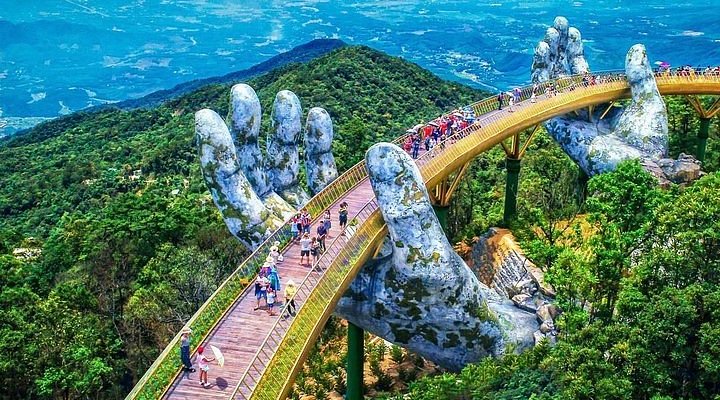 Featured
Featured  Featured
Featured Top Cafes at Train Street Hanoi
There is a series of charming cafes lining Hanoi’s Train Street. Some of the best are known for their service, access, and gorgeously picturesque aesthetics. Ga Dong Duong is particularly known for its coconut-flavoured coffee. Eisenbahn Kaffee, literally meaning ‘Railway Coffee’ in German, is a quaint coffee spot in Tran Phu. Hanoi 1990s Cafe is a favourite spot for both locals and tourists seeking a unique coffee experience with the thrill of watching trains pass by just inches away. Furthermore, Railway Cafe Hanoi, located near Tran Phu Street, is a family-run cafe offering rooftop seating as well. This is a better spot in terms of safety and has an elevated vantage point to take photographs.
What to Expect When the Train Passes By
This unusual street, though fondly named so, is not a street but a rail track. It might look like a normal bustling alleyway lined by colourful cafes and picturesque restaurants adorned with flower pots, floral creepers, and charming lanterns. But the path you walk on is a railway track, and a functional one as well. You would be sipping coffee in a cafe, only to feel the train first as the ground shakes, and you turn around to find a train slowly chugging away beside you, rattling the cafe and inches away from your body. Each of these elements is thrilling, but also poses as a treasure of content for clicking Instagrammable photographs.
Photography Tips
- For clicking the best-quality pictures at Hanoi Train Street, keep your smartphone aside and invest in a high-quality DSLR or mirrorless camera. A GoPro action camera is also a good choice to shoot at dynamic angles and for time-lapse videos.
- Try to reserve a spot with a good angle by reaching early so that you don’t click at the last minute as the train approaches, as you weren’t ready for the click as you expected.
- Look for unique vantage points. Look for cafes that have rooftop seating so that you can get an aerial shot. There are places where the tracks curve a bit, so you can get trains coming towards you from a slight angle.
- Look for the best lighting. The golden hour or early, misty mornings add a mystic charm to the photographs.
Seek places that are not crowded. Le Duan is more friendly and less crowded than Tran Phu. - Frame your camera using the rail tracks as a natural leading line for perspective. Also, don’t just click pictures of railway tracks and the train. The surrounding bustle, human compositions, and decor elements of the cafes are also worth capturing as candid moments to get a complete essence of your Hanoi photographic trip.
Travel Tips
- Arrive early to get the best vantage spots for perfect clicks.
- Make sure you keep a fair one or two-metre distance from the tracks for posing for photos or simply viewing the place. This is for your own safety. Also, stay clear of the tracks for posing for selfies or photographs. Listen to the locals and cafe owners, who will give you notice when the train is approaching.
- Respect the guidelines and safety protocols in place. Keep your head, hands, feet, and belongings away from the tracks when trains approach.
- Do not visit during late nights, as visibility will be quite poor. Also, the pictures come out better during the day or at golden hours.
- Use legal ways to enter the street. Do not climb over barricades or sneak past guards, as this can lead to hefty fines.
Conclusion
Train Street Hanoi could have been just an ordinary train track, one of many in Vietnam, but the locals’ unique urge to serve visitors along the tracks with some amazing Vietnamese coffee and delicacies makes it a top site for café culture in the city. The decor and aesthetics are splendid backdrops for photo ops. The chugging train adds a dramatic touch to your snapshots and amps up the thrill factor. This seamless blend of everyday life with the beat of the passing train offers an extraordinary experience that’s simply worth experiencing once in your lifetime. So, when you visit Hanoi, don’t forget to take a detour to this spectacular attraction – Train Street Hanoi.
